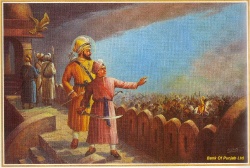Template:AOW86: Difference between revisions
Hari singh (talk | contribs) No edit summary |
Hari singh (talk | contribs) No edit summary |
||
| Line 3: | Line 3: | ||
[[Image:Jang.jpg|thumb|250px|left|<small>Sahibzada Jujhar Singh watches his brother Ajit Singh in action with their father, Guru Gobind Singh</small>]] | [[Image:Jang.jpg|thumb|250px|left|<small>Sahibzada Jujhar Singh watches his brother Ajit Singh in action with their father, Guru Gobind Singh</small>]] | ||
''' | '''Sahibzada Jujhar Singh''' ([[27 September]]{{eref|1|http://sgpc.net/Historical%20dates%20&%20events/date_september.asp}} [[1691]] - [[7 December]] [[1705]]), the second son of [[Guru Gobind Singh]], was born to [[Mata Jito|Mata Jito ji]] (also known as [[Mata Sundari|Mata Sundari ji]]) at [[Anandpur]] on 27 September 1691 (as per [[Nanakshahi calendar]]). | ||
He was one of the band that successfully waded through the flooded [[Sarsa]] rivulet on horseback and made good their way to [[Chamkaur]] by nightfall on 6 December 1705, with the adversary in hot pursuit. With little respite during the night, he participated in the next day's battle warding off assault after assault upon the "garhi", the fortified house in which [[Guru Gobind Singh]] had, along with his [[40 Sikhs]] and two sons, taken shelter. As they ran out of ammunition and arrows, Sikhs inside split themselves into batches of five each who would go out one after the other to engage the besiegers in hand to hand combat. Jujhar Singh led the last sally towards the end of the day (7 December 1705), and laid down his life fighting near the place where he had earlier seen his elder brother fall. He was just 14 years old when he gave his life while his [[Ajit Singh|older brother]] was 18 years old when they gave their lives for their faith. [[Gurdwara Katalgarh Sahib]] in [[Chamkaur Sahib]] now marks the site. | Like his elder brother, [[Ajit Singh]], he started training in the fighting skills ([[Gatka]]) as soon as he started learning the religious texts aged about 4 to 5 years. In 1699, when he was eight years old, he received holy [[Amrit]] at the rites of [[Khalsa]] initiation, called [[Amrit Sanskar]]. By the time it became necessary to leave [[Anandpur]] under the pressure of a besieging host in December 1705, Jujhar Singh, nearing the completion of his fifteenth year, was an experienced young warrior, strong and fearless. | ||
He was one of the band that successfully waded through the flooded [[Sarsa]] rivulet on horseback and made good their way to [[Chamkaur]] by nightfall on 6 December 1705, with the adversary in hot pursuit. With little respite during the night, he participated in the next day's battle warding off assault after assault upon the "garhi", the fortified house in which [[Guru Gobind Singh]] had, along with his [[40 Sikhs]] and two sons, taken shelter. <!---------- | |||
As they ran out of ammunition and arrows, Sikhs inside split themselves into batches of five each who would go out one after the other to engage the besiegers in hand to hand combat. Jujhar Singh led the last sally towards the end of the day (7 December 1705), and laid down his life fighting near the place where he had earlier seen his elder brother fall. He was just 14 years old when he gave his life while his [[Ajit Singh|older brother]] was 18 years old when they gave their lives for their faith. [[Gurdwara Katalgarh Sahib]] in [[Chamkaur Sahib]] now marks the site. ----> <big>'''[[Sahibzada Jujhar Singh|....Continued.]]'''</big> | |||
Revision as of 17:34, 1 September 2009
Sahibzada Jujhar Singh
Sahibzada Jujhar Singh (27 September1 1691 - 7 December 1705), the second son of Guru Gobind Singh, was born to Mata Jito ji (also known as Mata Sundari ji) at Anandpur on 27 September 1691 (as per Nanakshahi calendar).
Like his elder brother, Ajit Singh, he started training in the fighting skills (Gatka) as soon as he started learning the religious texts aged about 4 to 5 years. In 1699, when he was eight years old, he received holy Amrit at the rites of Khalsa initiation, called Amrit Sanskar. By the time it became necessary to leave Anandpur under the pressure of a besieging host in December 1705, Jujhar Singh, nearing the completion of his fifteenth year, was an experienced young warrior, strong and fearless.
He was one of the band that successfully waded through the flooded Sarsa rivulet on horseback and made good their way to Chamkaur by nightfall on 6 December 1705, with the adversary in hot pursuit. With little respite during the night, he participated in the next day's battle warding off assault after assault upon the "garhi", the fortified house in which Guru Gobind Singh had, along with his 40 Sikhs and two sons, taken shelter. ....Continued.

